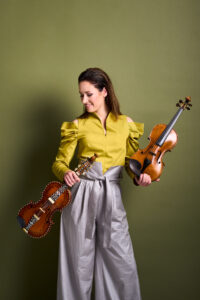Brighton Philharmonic Orchestra
Adam Hickox, Ragnhild Hemisng, Joanna MacGregor
Brighton Dome 07 April 2024
It was a consistently watery, or at least maritime, concert in which two very well-worn pieces bookended two much less familiar ones.
BPO, led on this occasion by Nicky Sweeney, launched the concert with Britten’s wonderfully evocative Four Sea Interludes from Peter Grimes. They negotiated the very exposed opening with aplomb, gave us some dramatically percussive rain drops and a reasonably balanced storm. And if the syncopated passage in Sunday Morning got a bit slippery, then Hickox and Sweeney soon hauled it back.
Then came the Geirr Trevitt’s Violin Concerto no 2 Op 252 for Hardanger Fiddle Three Fjords and the charismatic Ragnhild Hemsing. As I suspect it was for most of the audience, this was terra nova for me. The Hardanger Fiddle which developed in Norway in the 17th century has eight strings and is usually elaborately decorated. It is also slimmer and therefore quieter than a violin so Hemsing had a small microphone at her feet. Four of the strings are simply there to resonate so all the dramatic rhythms in this engaging piece rang out with an interesting drone effect. The section in which the soloist is accompanied by snare drum and then xylophone was particularly effective. Of course, when it was done, her encore comprised two traditional dance tunes in which the orchestra cheerfully added the requisite foot tapping. I am now longing to have a go on a Hardanger Fiddle (in private!)

Joanna MacGregor, BPO’s very hands-on, impressively polymathic Artistic Director, appeared after the interval to conduct Ryuichi Sakamoto’s Still Life, Bibo non Aozora and Happy End from the piano. Moving from piano stool to stand in front of the second violins or, for the third piece, to the podium, she found plenty of warm richness in these three miniatures. The section in the last one in which the string melody sits on clucking underpinning from the wind was attractive and of course MacGregor is, as ever, a commensurate team player playing her rippling part without gratuitous showiness. It must, for all concerned, be a pleasure to explore a piece so relatively unknown but with so many melodic rewards.
And so to the warhorse which finally brought the tide in. As Hickox and MacGregor agreed during a short discussion while the piano was moved off stage and the full orchestra restored, Claude Debusy’s La Mer is one of the most cherished orchestral pieces in the repertoire. Interesting moreover that MacGregor attributes that unmistakable “French” sound to the passion which Debussy and his contemporaries had for gamelans
Hickox really leaned, as you must to La Mer work, on the oceanic climaxes with some stylish brass and percussion contributions in the first movement. The second movement with the two harps was a highlight too. It was a business-like performance of what is, effectively, a highly programmatic symphony in three movements. MacGregor calls it “an orchestral triptych”.
A concert which gave us two hours on the water – in a range of settings and moods – was an imaginative way of ending BPO’s season (they’ll be back in September) given that The Dome is only a few hundred yards from the sea. It’s fun, too, to reflect that Debussy went to nearby Eastbourne to correct the proofs for La Mer so the Sussex links are alive and well.